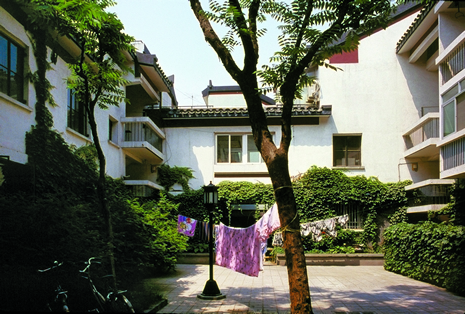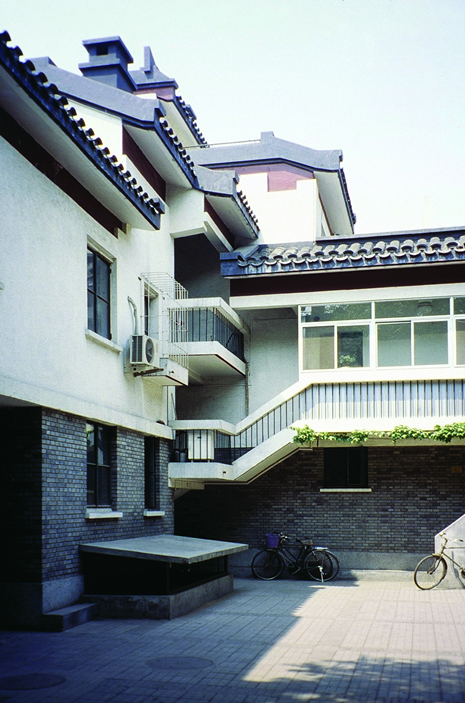Description
This project description is an excerpt from the longer article “Indigenous Reinterpretations”. For a comparative analysis and further data on this and all other categories including accompanying graphs, please see the article “A Turning Point”.
Movement through the siheyuan, depending upon one’s familiarity with the owners and how far one went, probably involved up to five turns with deliberate pauses and all orchestrated according to the doctrine of li, and proprietous and courteous behavior. In other words, the siheyuan and hutong location facilitated a desirable and preferred form of social interaction. According to the Qianlong Map of 1735, for instance, substantial areas of Beijing, outside of the Forbidden City precinct, were occupied in this manner.
[1]
Indeed, the first project under discussion, the Ju’er Hutong by Wu Liangyong of 1989 to 1992, was originally a small part of this broader context in the north-eastern Dongcheng District of old Beijing.
From the outset, Wu recognized that it would have been impossible to preserve all the courtyard houses without introducing any interventions, and yet, it would have been unwise to maintain them in an ossified state. In his view, features that have fallen out of pace with demands of contemporary life would have to be adapted, and the rehabilitation of these traditional residential districts in the Old City of Beijing, primarily within the confines of the Second Ring Road, ought to occur as a process of “organic renewal”, hinging on “metabolic change rather than total clearance and rebuilding”.
[2]
The Ju’er Hutong project was thus a pilot project in Wu’s application of a practical methodology that would “enable the preservation of the historical and cultural value of the Old City as well as promote sustainable development and provide a solution to the housing shortage” the city was then facing in the 1980s and early 1990s.
[3]
Since the establishment of the People’s Republic in 1949, extensive industrial development and the concentration of government offices and commercial enterprises within the Old City resulted in severe congestion and deterioration of the urban-environmental quality. Moreover, the construction of nearly seven million square meters of new housing between 1974 and 1986 alone, or 70 percent of the city’s total new housing development since the Communists took power, was associated with uncontrolled infill, often in the form of high-rises that compromised the horizontal character of the Old City and greatly reduced the open spaces and leafy environments.
[4]
The Ju’er Hutong is located in what was formerly known as the Zhaohui-Jinggong Fang, a neighborhood block dating back to the Yuan dynasty and built around 1267 and 1290 A.D., and retained the original block layout with nine east-west parallel hutong crossed by one north-south street.
[5]
Since time immemorial, this physical layout of the Old City in the form of neighborhoods composed of courtyards has been integral to the evolution of community life, with a number of Chinese literary works celebrating the socio-cultural life in these communities based on mutual respect and aid. In fact, the courtyard typology lends itself to the fostering of such amiable ties and sense of communal identity with its intimate scale, close relation between the indoor and outdoor spaces, and distinction between the public space of the lane and the semi-public/private space of the courtyard. Further, the attractiveness of the courtyard housing also lies in its union of natural beauty within a man-made environment, incorporating gardens, trees, and plants that offer respite from the hustle and bustle in the lands, and its inherent adaptability to accommodate live-work spaces. The 8.2-hectare block occupied by Ju’er Hutong had deteriorated considerably with poor housing conditions by the time it was selected as an experimental site for renewal by the Dongcheng District in 1989. Despite the overcrowding, poor environmental conditions and utilities, frequent flooding, and its degeneration into a dazayuan or “big cluttered courtyard”, Ju’er Hutong was home to a close-knit community of some 3,180 residents where neighbors would help each other out.
[6]
The design team from Tsinghua University led by Wu Liangyong thus resolved to: (i) improve the living conditions of the community through the creation of a new courtyard housing prototype that would attain an ideal balance between insolation and ventilation while increasing the intensity of land use; (ii) “respect, support, and enhance the residents’ attachments to each other and their place”; and (iii) to allow them to regain the sense of privacy and spatial control originally afforded by the traditional courtyard environment.
[7]
Research and surveys of the area had already been undertaken in 1987, and the rehabilitation was organized to be carried out in four phases, of which only Phases I and II were materialized. From the exterior, the redeveloped neighborhood blends seamlessly into its surrounding fabric of low-rise, grey brick courtyard housing, distinguished by just its white, stuccoed walls rising two- to three-storeys above grade, striated by bands of sliding windows. Crowning these new apartment clusters are roofs that are partially pitched and composed of traditional grey-tiled patterns, inspired clearly by the architectural language of the classic siheyuan. Despite the height difference with adjacent one- to two-storey courtyards, these modern additions are not at all imposing. Instead, their presence is softened by setting them back from the hutong and incorporating lower garden walls of traditional grey brick and wrought iron on their periphery. From the hutong, the courtyard clusters are entered in via an articulated gateway that continues as a system of lanes or public alleyways that later branch off into communal courts before one gains access to the units arranged around the courts, reminiscent of the orchestrated movement in the siheyuan of the past which similarly reflected the transitions between zones of differing public-private characters. Old trees were preserved, and serve as departure points for where the communal courts would be located, complete with planter boxes, lamp posts, new trees, and garden furniture like stone benches, tables, and stools.
By way of housing, the apartments were arrayed in two- to three-storey courtyard types that were built within the height restriction of nine meters, allowing for a higher floor area ratio and density comparable to mid-rise residential blocks. In doing so, Wu and his team were able to introduce roof garden terraces, thereby creating more private outdoor space for communal purposes, including planting – an important traditional pastime – as well as opening up views to the Old City and its historic landmarks. Within the clusters, lofts were also made possible under the pitched roofs, providing for more useable space in the attics, and enhancing the rooflines of the project in concert with the rooftop terraces. Besides extending the elevation upwards, additional floor space was created through the introduction of basements in Phase II of the development, once the drainage problems were resolved. With large windows, light-wells, and sunken outdoor patios, these basement apartments were pleasing and well received. Vernacular Chinese architectural elements embellished the courtyard clusters, ranging from ornamented doorways and entrance screens to elaborate door knockers that imbued a sense of belonging and tradition in what otherwise were modern, figural interpretations of the old siheyuan typology. In Phase I, 64 bays of old housing made way for 46 new apartment units with a total floor area of 2,760 square meters, the equivalent of 2.5 times the space prior to the renewal.
[8]
A variety of unit types were included to cater to a range of households, from young or elderly couples, to families and intergenerational living, and the average floor area per person was improved from 7.86 square meters to 20.75 square meters. In Phase II, a collection of individual courts were designed in response to the site conditions around the transistor factory, and included a community center of some 300 square meters in area to complement the modest elderly residents activity centre that doubled up as an after-school youth activity centre. During this second phase 164 new apartment units were built, with a total floor area of 17,897 square meters, and increases in average floor area per person from 11.49 square meters to 26.25 square meters.
It must be said, however, that the project was not a wholesale demolition and redevelopment of a dilapidated neighborhood. In fact, in keeping with Wu’s argument for organic renewal, some of the original courtyard houses that were still structurally sound and of notable architectural quality were preserved, including a cluster adjacent to Phase I of the development. In addition, existing buildings such as a small transistor factory dating from the Communist era emphasizing industrial production, as well as a research institute next to Phase II of the project, were retained. To manage the renewal and resettlement of the original residents, a housing cooperative was established during the first phase. As China was undergoing housing reforms, moving away from state-provided free housing to market-oriented conditions, a system of cost sharing was put in place such that the cost of rehabilitation was shared between the local Dongcheng District Government, the residents, and the work units that employed the residents. Under this system, original resident households would pay 350 yuan per square meter, while their employers paid 250 yuan per square meter, and the rest was covered by government subsidies. Residents with the ability to pay thus obtained the use rights to the new units, which could be transacted through the market five years after the purchase; those who were unable to afford the costs or who were unwilling to move back to the new units were provided with good-quality accommodation elsewhere, with the remaining units sold by the cooperative at market rate to cover the remaining costs while generating a surplus for further work to be conducted.
9
Wu, Rehabilitating the Old City of Beijing, 140 and 144; “Ju’er Hutong Courtyard Housing Project, Beijing,” World Habitat Awards, accessed November 24, 2013, http://www.worldhabitatawards.org/winners-and-finalists/project-details.cfm?lang=00&theProjectID=119
Overall, 13 of the original households in Phase I returned after the renewal, and another 48 of the original households in Phase II, equivalent to 31.7 percent and 23.5 percent of the original total. This system of cost sharing was not just a means of shifting towards a housing market in the early days of housing reform, but also enabled part of the original community to be retained – a highly laudable social goal in and of itself. Given the close ties of the original residents, this gesture allowed the social fabric or at least some parts of it to be preserved, rather than the conventional disintegration of such a community in urban renewal projects. In sum, Ju’er Hutong is not about master plans per se but an instance of how the extraordinary hutong structure can be redeveloped in Beijing, merging both traditional and modern architecture whilst still maintaining the underlying spatial logic and principles of the traditional courtyard house within contemporary lifestyle and urban demands. In essence, this has given rise to a viable prototype that provided for relatively high-density housing within low-rise, mixed-use circumstances, revitalizing this historic capital’s inner-city life even in the modern day.
Footnotes
Peter G. Rowe and Seng Kuan, Architectural Encounters with Essence and Form in Modern China (Cambridge, MA: MIT Press, 2002), 8–15.
Liangyong, Wu, Rehabilitating the Old City of Beijing: A Project in the Ju’er Hutong Neighbourhood (Vancouver: University of British Columbia Press, 1999), xix.
Wu, Rehabilitating the Old City of Beijing, xx.
Wu, Rehabilitating the Old City of Beijing, 51.
Wu, Rehabilitating the Old City of Beijing, 77.
Wu, Rehabilitating the Old City of Beijing, 104–115.
Wu, Rehabilitating the Old City of Beijing, 114.
Wu, Rehabilitating the Old City of Beijing, 140.
Wu, Rehabilitating the Old City of Beijing, 140 and 144; “Ju’er Hutong Courtyard Housing Project, Beijing,” World Habitat Awards, accessed November 24, 2013, http://www.worldhabitatawards.org/winners-and-finalists/project-details.cfm?lang=00&theProjectID=119
Drawings
Photos
 View from courtyard
View from courtyard
 View from courtyard
View from courtyard
Originally published in: Peter G. Rowe, Har Ye Kan, Urban Intensities: Contemporary Housing Types and Territories, Birkhäuser, 2014.